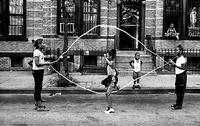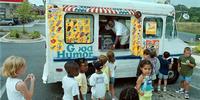#OneBookWednesday: Another Brooklyn, Another Time, Another Childhood
By Julie B.Author Jacqueline Woodson has said that as much as Another Brooklyn is the story of August, who we see progress from childhood to adulthood, it is the story of a place—Bushwick, New York. And just as we get to know the characters and they come alive for us, so too do we readers come to know and feel this pocket in Brooklyn. In the pulsing beats of Woodson’s pages, we feel the vibrancy of corner stores and park parties and stoop sitting, and we hear the voices and laughs and songs echoing up from the pages.
Through this, the Brooklyn of Another Brooklyn also calls back to another era—one filled with jump rope, jacks, chasing ice cream trucks, and dancing in fire hydrants. In the same time in other places, children rode bikes through neighborhoods and played at the park sans supervision, only returning home at dusk for dinnertime. It was a time in which the definition of childhood was freedom.
August’s father, after moving her and her brother north from Tennessee, isn’t comfortable at first with the freedoms of this Brooklyn neighborhood. He keeps his children inside their Brooklyn apartment, where they are left to look out a window at other children playing. But eventually he loosens the reins, allowing them farther and farther from the apartment:
“The front gate first—Stay inside it. Keep it closed. Then to the tree in the middle of the block. Then to the STOP sign on the corner. Around the corner to Poncho’s bodega, but only together. Hold your brother’s hand. Then onto the curb, into the street, the handball court, down Knockerbocker, across to the park, the baby swings, the big swings, until my brother and I were finally free” (33).
FREE.
But is such childhood freedom a thing of the past?
Today, many children—typically those not growing up in cities, but even there—are kept under watchful eye, and their schedules are often filled to the brim with planned activities: music, art, dance, sports, playdates. This oversight and programming is done with the deepest love—parents want to keep their children safe and give them avenues and tools to bolster their creativity and sociability. But we sometimes forget how creative an open, un-adulted afternoon with the kids on the block could be. Elaborately choreographed swingset circuses! Complex watergun wars! Hours-long jump-rope dance battles! Long conversations with best friends on their way to becoming.
Some parents who have tried to engender such freedoms for their own children have ended up in hot water. In 2015, a couple in Maryland was investigated multiple times by Child Protective Services for letting their children walk home from the park without them, and there were similar cases in South Carolina and Florida.
Lenore Skenazy, author of the book Free-Range Kids, attributes such cases to societal fear: “We've been encouraged in our society to do what I call worst-first thinking, which is come up with the worst-case scenario first and proceed as if it's likely to happen.”
Woodson’s August acknowledges the fears youth faced in her Brooklyn: "We had blades inside our kneesocks and were growing our nails long. … But Brooklyn had longer nails and sharper blades" (61). And later: "We pretended to believe we could unlock arms and walk the streets alone. But we knew we were lying" (74). They knew there were bad things out there … but perhaps they also had gained the skills to deftly cope with and manage such challenges.
Parents are rightly worried about protecting their children. But when they hug them tighter, does something else get lost? Is there a happy medium between keeping kids safe and giving them meaningful freedom?
**Only two more weeks until the 16th season of One Book, One Philadelphia kick offs! Check back every #OneBookWednesday for some more One Book food-for-thought!**
Have a question for Free Library staff? Please submit it to our Ask a Librarian page and receive a response within two business days.



